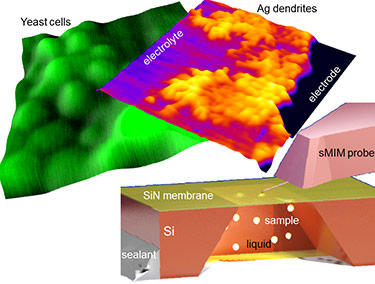
U.S. government nanotechnology researchers have demonstrated a new window to view what are now mostly clandestine operations occurring in soggy, inhospitable realms of the nanoworld—technologically and medically important processes that occur at boundaries between liquids and solids, such as in batteries or along cell membranes.
The new microwave imaging approach trumps X-ray and electron-based methods that can damage delicate samples and muddy results. And it spares expensive equipment from being exposed to liquids, while eliminating the need to harden probes against corrosive, toxic, or other harmful environments.
Writing in the journal ACS Nano, the collaborators—from the Center for Nanoscale Science and Technology at the National Institute of Standards and Technology (NIST) and the Department of Energy's Oak Ridge National Laboratory (ORNL)—describe their new approach to imaging reactive and biological samples at nanoscale levels under realistic conditions.
The key element is a window, an ultrathin membrane that separates the needle-like probe of an atomic force microscope (AFM) from the underlying sample, held in tiny containers that maintain a consistent liquid or gas environment. The addition transforms near-field microwave imaging into a versatile tool, extending its use beyond semiconductor technology, where it is used to study solid structures, to a new realm of liquids and gases.
"The ultrathin, microwave-transparent membrane allows the sample to be examined in much the same way that Earth's radar was used to reveal images of the surface of Venus through its opaque atmosphere," explained NIST physicist Andrei Kolmakov.
"We generate microwaves at the apex—or very end—of the probe tip," Kolmakov said. "The microwaves penetrate through the membrane a few hundred nanometers deep into the liquid up to the object of interest. As the tip scans the sample from across the membrane, we record the reflected microwaves to generate the image."
Microwaves are much larger than the nanoscale objects they are used to "seeing." But when emitted from only a minuscule distance away, near-field microwaves reflected from a sample yield a surprisingly detailed image.
In their proof-of-concept experiments, the NIST-ORNL team used their hybrid microscope to get a nanoscale view of the early stages of a silver electroplating process. Microwave images captured the electrochemical formation of branching metal clusters, or dendrites, on electrodes. Features nearly as small as 100 nanometers (billionths of a meter) could be discerned.
As important, the low-energy microwaves were too feeble to sever chemical bonds, heat, or interfere in other ways with the process they were being used to capture in images. In contrast, a scanning electron microscope that was used to record the same electroplating process at comparable levels of resolution yielded images showing delamination and other destructive effects of the electron beam.
The team reports similar success in using their AFM-microwave set-up to record images of yeast cells dispersed in water or glycerol. Levels of spatial resolution were comparable to those achieved with a scanning electron microscope, but again, were free of the damage caused by the electron beam.
In their experiments, the team used membranes—made either of silicon dioxide or silicon nitride—that ranged in thickness from 8 nanometers to 50 nanometers. They found, however, that the thinner the membrane the better the resolution—down to tens of nanometers—and the greater the probing depth—up to hundreds of nanometers. "These numbers can be improved further with tuning and development of better electronics," Kolmakov said.
In addition to studying processes in reactive, toxic, or radioactive environments, the researchers suggest that their microwave-imaging approach might be integrated into "lab-on-a-chip" fluidic devices, where it can be used to sample liquids and gases.
The research was performed at NIST's Center for Nanoscale Science and Technology and at the Center for Nanophase Materials Sciences, a Department of Energy Office of Science User Facility.
Article: A. Tselev, J. Velmurugan, A.V. Ievlev, S.V. Kalinin and A. Kolmakov. "Seeing through Walls at the Nanoscale: Microwave Microscopy of Enclosed Objects and Processes in Liquids," ACS Nano, Article ASAP. DOI: 10.1021/acsnano.5b07919

